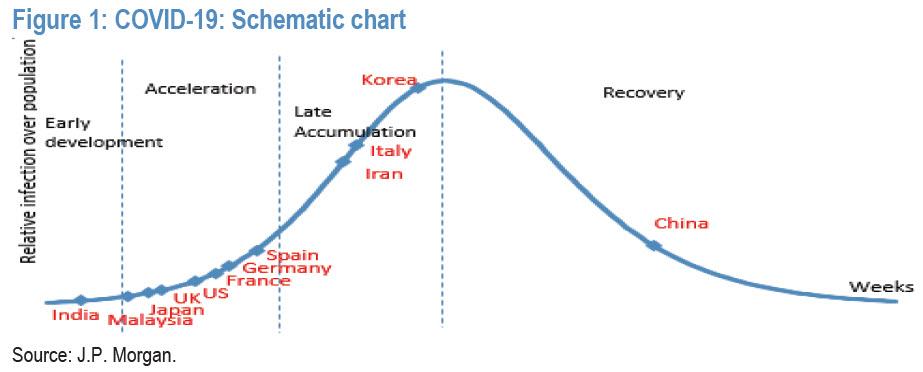Here Is Where The World Now Is On The “Corona Curve” At This Moment
With 1.7 billion people in the world under quarantine (and India about to make that 3 trillion) and desperate to find out where on the coronavirus “curve” they are to calculate how much more pain there is, JPM has made an attempt at a (very nonscientific) visual representation of where on the curve the main covid outbreaks in the world currently stand.
The good news, China has is now well into the recovery phase, although since any and every number out of China is a lie, we would ignore any reports that the covid pandemic in China is easing especially after a spate of recent indications that China is openly manipulating its infection numbers. Also good news: Korea is almost “over the hump”, and absent new clusters emerging in the next few days, should be in recovery.
Now the not so good news: both Italy and Iran are in the “late accumulation” phase. If they fail to halt the breakout at this point as the recovery phase approaches, it will get very ugly as much of the local population could then be infected. Behind Italy and Iran is the rest of Europe, with Spain, Germany, France, the UK all in the acceleration phase. The onus in on them to execute successful lockdowns.
Finally, the bad news: both the US and India are at the very start of the curve and things will get much uglier in the coming weeks before they get better.
Some more observations from JPM:
Global infections accelerated 14% d/d or 45,495 new cases over the last 24 hours to 381,499 according to Johns Hopkins, implying the global curve may be gradually shifting toward an early acceleration stage. The US (13,060 d/d), Spain (6,368 d/d), Italy (4,789 d/d) and Germany (4,183 d/d) reported the most new infections. In Asia, China’s Hubei reported one new infection after 5 days of no new increase. As recent infection spike in Hong Kong SAR and Singapore suggests, as long as the global infection curve is developing, premature relaxation of heightened community risk awareness could set off a rebound of a controlled infection curve or a second infection wave. From that vantage, China’s full lift on Wuhan city on 8-Apr bears close watching in our view as infections may appear to persist in society for at least one month. In ASEAN, 212 new cases were reported in Malaysia, taking total infection to 1,518. Our epidemiology model suggests a mid-April infection peak. Our Australian team reviewed the strategy taken by the government and introduced an epidemiology model, forecasting a possible peak in new cases around 15 April.
Finally, as we noted last night, Trump is now eager to recreate China’s experience and reopen the economy in under 2 weeks to avoid a second great depression. Needless to say, this will be problematic unless the US shifts into the recovery phase by then.
Tyler Durden
Tue, 03/24/2020 – 12:21
